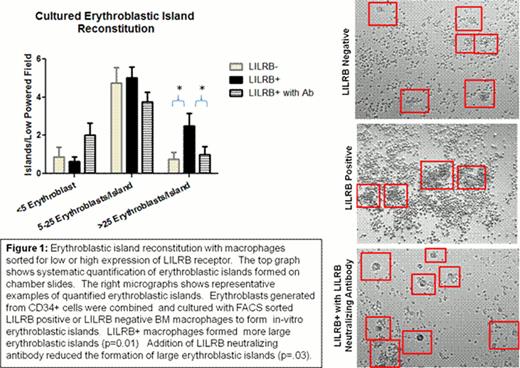Abstract
Abstract 3190
Erythropoiesis occurs in a unique bone marrow (BM) microenvironment known as erythroblastic islands. Erythroblastic islands are composed of erythroid precursors in close contact with specialized stromal macrophages, also referred to as central or island macrophages. Human erythroblastic island macrophages have been difficult to discern from other macrophage subpopulations by cell surface markers, although they have reduced expression of C3b receptor (CD35) (Lee et al., 1988). The unique non-antigen presenting nature of erythroblastic island macrophages led us to hypothesize that it may share surface receptors of other tolerogenic macrophages subpopulations, including leukocyte immunoglobulin-like transcript B receptors (LILRB).
We first identified a distinct subset of human bone marrow macrophages with flow cytometry, which express high amounts of LILRB1 and LILRB2 surface receptors, have low expression of C3b surface receptor (p<0.05), and have increased expression of VCAM-1 surface receptor. This macrophage subpopulation consisted of 1 in 500 (0.02%) of bone marrow mononuclear cells. Functionally, when we FACS sorted human BM enriched erythroid precursors (CD45−/CD71+) and combined them with FACS sorted LILRB1+/LILRB2+ (LILRB+) or LILRB1−/LILRB2- (LILRB−) BM macrophages, there were no significant differences in erythroblastic island reconstitution, suggesting that the adhesion of primary BM erythroblasts to island macrophages is not related to macrophage LILRB expression. Since our ex-vivo erythroid population was enriched for late precursors, we tested island reconstitution with CD34+ cell-derived cultured erythroblasts and FACS sorted LILRB+ or LILRB- BM macrophages, which resulted in a significantly higher number of large proliferative erythroblastic islands (>25 erythroblasts/island macrophage) in LILRB+ compared with LILRB- macrophages (p<0.05) (Figure 1). Incubation with neutralizing anti-LILRB1/LILRB2 antibodies did not prevent primary erythroblastic island reconstitution independent of expression of LILRB by macrophages. However, anti-LILRB1/LILRB2 did prevent the formation of large erythroblastic islands indicating a specific role of LILRB in optimal island reconstitution and erythropoiesis (p<0.05) (Figure 1). In conclusion, we demonstrate that LILRB+ BM macrophages increase the formation of large in-vitro erythroblastic islands and LILRB receptors are important candidate receptors for functional regulation of erythropoiesis.
No relevant conflicts of interest to declare.
Author notes
Asterisk with author names denotes non-ASH members.


This feature is available to Subscribers Only
Sign In or Create an Account Close Modal